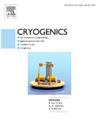Modeling spray-bar pressure control of a large-scale liquid-hydrogen propellant tank in normal gravity
IF 2.1
3区 工程技术
Q3 PHYSICS, APPLIED
引用次数: 0
Abstract
A two-phase Eulerian–Lagrangian CFD framework was developed and validated for simulating spray-bar pressure control in the Multipurpose Hydrogen Test Bed (MHTB) liquid hydrogen tank at a 25% fill level. Simulations were conducted for three configurations: a quarter-tank sector with symmetry planes, a full tank with a centrally located spray-bar, and a full tank with an experimentally accurate off-center spray-bar. The model couples a volume-of-fluid (VOF) approach with an in-house T-sat droplet sub-model that accounts for breakup, coalescence, and heat and mass transfer to the ullage vapor. All cases accurately reproduced the experimentally measured pressure reduction and ullage temperature decay during the 35-s spray cycle. The quarter-sector simulation closely matched the full-tank results while reducing computational time from weeks to days, indicating its suitability for rapid system-level studies. The full-tank representation remains necessary only when detailed ullage temperature distributions or asymmetries must be resolved. The validated framework offers a computationally efficient tool for evaluating spray-bar design parameters and supporting the development of future cryogenic fluid management systems for spaceflight applications.
正重力下大型液氢推进剂储罐喷雾杆压力控制建模
建立并验证了两相欧拉-拉格朗日CFD框架,用于模拟25%填充水平下多用途氢气试验台(MHTB)液氢罐的喷雾杆压力控制。对三种配置进行了模拟:对称平面的四分之一罐扇形,位于中心位置的满罐喷雾棒,以及具有实验精确的偏离中心的满罐喷雾棒。该模型将流体体积(VOF)方法与内部的T-sat液滴子模型相结合,该模型考虑了破裂、聚结以及热量和质量向蒸汽的传递。在35 s的喷雾周期内,所有情况都能准确地再现实验测量的压力降低和温度衰减。四分之一扇区模拟与全油罐的结果非常接近,同时将计算时间从数周减少到数天,表明其适用于快速的系统级研究。只有在必须解决详细的空载温度分布或不对称时,才需要用满舱表示。经过验证的框架为评估喷雾杆设计参数和支持未来航天应用的低温流体管理系统的开发提供了一个计算效率高的工具。
本文章由计算机程序翻译,如有差异,请以英文原文为准。
求助全文
约1分钟内获得全文
求助全文
来源期刊

Cryogenics
物理-热力学
CiteScore
3.80
自引率
9.50%
发文量
0
审稿时长
2.1 months
期刊介绍:
Cryogenics is the world''s leading journal focusing on all aspects of cryoengineering and cryogenics. Papers published in Cryogenics cover a wide variety of subjects in low temperature engineering and research. Among the areas covered are:
- Applications of superconductivity: magnets, electronics, devices
- Superconductors and their properties
- Properties of materials: metals, alloys, composites, polymers, insulations
- New applications of cryogenic technology to processes, devices, machinery
- Refrigeration and liquefaction technology
- Thermodynamics
- Fluid properties and fluid mechanics
- Heat transfer
- Thermometry and measurement science
- Cryogenics in medicine
- Cryoelectronics
 求助内容:
求助内容: 应助结果提醒方式:
应助结果提醒方式:


